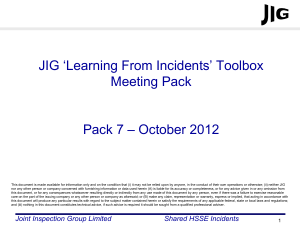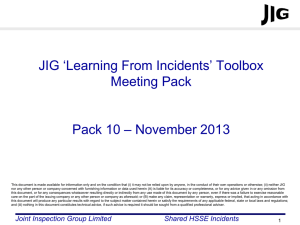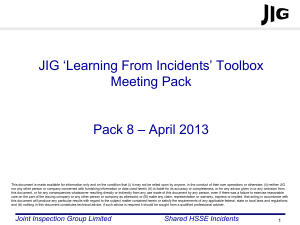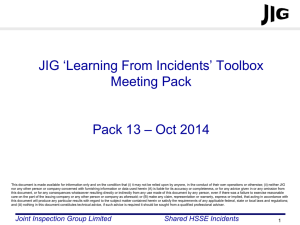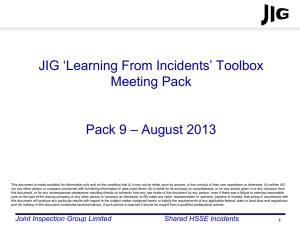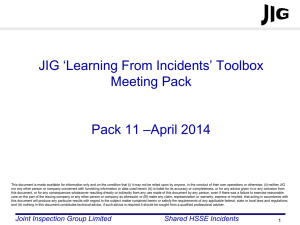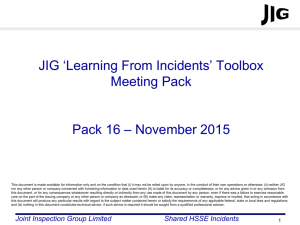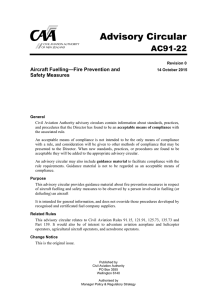JIG LFI Toolbox Pack 15 - Joint Inspection Group
advertisement
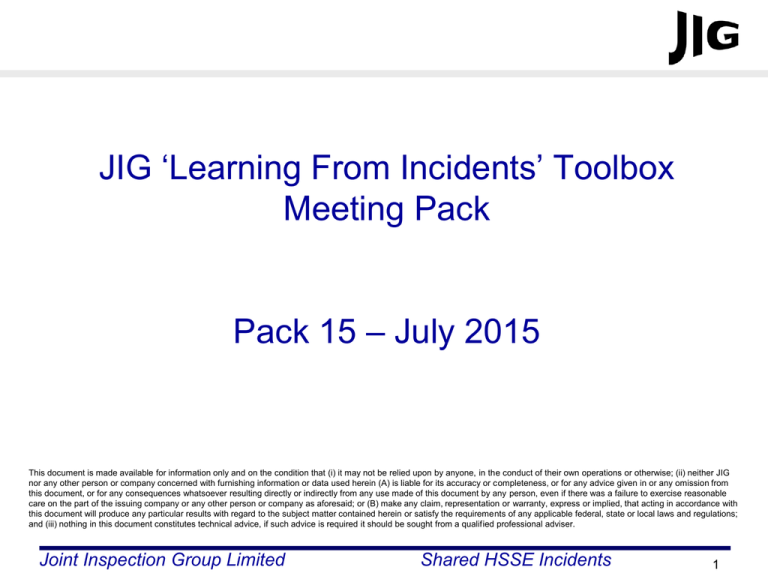
JIG ‘Learning From Incidents’ Toolbox Meeting Pack Pack 15 – July 2015 This document is made available for information only and on the condition that (i) it may not be relied upon by anyone, in the conduct of their own operations or otherwise; (ii) neither JIG nor any other person or company concerned with furnishing information or data used herein (A) is liable for its accuracy or completeness, or for any advice given in or any omission from this document, or for any consequences whatsoever resulting directly or indirectly from any use made of this document by any person, even if there was a failure to exercise reasonable care on the part of the issuing company or any other person or company as aforesaid; or (B) make any claim, representation or warranty, express or implied, that acting in accordance with this document will produce any particular results with regard to the subject matter contained herein or satisfy the requirements of any applicable federal, state or local laws and regulations; and (iii) nothing in this document constitutes technical advice, if such advice is required it should be sought from a qualified professional adviser. Joint Inspection Group Limited Shared HSSE Incidents 1 Learning From Incidents How to use the JIG ‘Learning From Incidents’ Toolbox Meeting Pack • The intention is that these slides promote a healthy, informal dialogue on safety between operators and management. • Slides should be shared with all operators (fuelling operators, depot operators and maintenance technicians) during regular, informal safety meetings. • No need to review every incident in one Toolbox meeting, select 1 or 2 incidents per meeting. • The supervisor or manager should host the meeting to aid the discussion, but should not dominate the discussion. • All published packs can be found in the publications section of the JIG website (www.jigonline.com) Joint Inspection Group Limited Shared HSSE Incidents 2 Learning From Incidents For every incident in this pack, ask yourselves the following questions: • What is the potential for a similar type of incident at our site? • How do our risk assessments identify and adequately reflect these incidents? • What prevention measures are in place and how effective are they (procedures and practices)? • What mitigation measures are in place and how effective are they (safety equipment, emergency procedures)? • What can I do personally to prevent this type of incident? If you would like further assistance or information relating to the information contained in this pack please contact JIG via http://www.jigonline.com/contacts/ Joint Inspection Group Limited Shared HSSE Incidents 3 Hydrant Line Fire – Control of Work LFI 2015-06 Incident Summary – During the cutting of a Jet A-1 hydrant line using an angle grinder, the product remaining in the pipe ignited. There were no injuries. The pipeline involved had previously been emptied. It was unclear whether the pipeline was completely dry and had been formally released for all of the works to be performed on the day of the incident. A permit to work was issued and prior to cutting, a hole was drilled in the pipe to test for fluid, with some “gas” being released through the hole. This was assumed to be nitrogen introduced during an earlier inspection using an intelligent pig. It is unclear whether a gas test had been carried out before the pipe was cut. As the angle grinder cut through the pipe, a small amount of fluid sprayed briefly from the pipeline (estimated 2 litres). As the spray was limited and the assumption was that the pipeline was under nitrogen pressure, the cutting continued. Before the third cut was made, the foreman saw flames coming from the previous cuts. In response, two dry powder extinguishers were discharged into the cuts but most of the powder did not enter the pipe as the cuts were too narrow. As it was unclear whether the fire had been extinguished, the original hole that had been drilled was enlarged and a third extinguisher was discharged through it. Subsequently, holes were drilled and argon was fed into the pipe on both sides of the existing cut. Causes – • • • • • • • Hot work techniques were applied to a pipeline which still had jet A-1 present instead of cold cutting. The work scope, procedures, methods had not been reviewed and approved by a competent person and no task risk assessment (TRA) had been performed. The permit to work was inadequate/too generic and did not specify gas testing. There was insufficient involvement, knowledge and supervision by all parties. The pipeline was not formally released for cutting. The risk awareness of site staff and contractors was insufficient. There was no procedure/work instruction for cutting through a pipeline or for work with inert gases. Discussion Points – • • • • • Do you have the necessary knowledge and expertise to put in place safe working practices for work on live pipelines. Are you aware of or have the ability to identify the industry standards/codes of practice for the cutting of pipelines and other high risk activities? Are your site permit procedures robust and correctly applied? Remember that a permit to work doesn’t necessarily mean the work is safe, it is only one part of a safe system of work. Are accountabilities clear and risk assessments undertaken prior to works? Are staff empowered to stop working or stop the task if they feel it is unsafe? Can you think of any similar situations that YOU have experienced or witnessed? Did you report it? Joint Inspection Group Limited Shared HSSE Incidents 4 Damage to Aircraft during fuelling operations LFI 2015-07 Incident Summary – During the fuelling of a 777-200 in Feb 2015, damage was caused to the outer thrust reverser cowling on the aircraft’s port engine when the aircraft settled onto the open door of the hydrant servicer as the weight of fuel on board increased during the fuelling. As the fuel was delivered the engine lowered onto the top of the door. The operator heard a 'crack' sound and saw that the door had punctured the engine cowling. There have been other recorded incidents where such damage has been caused:1. Hydrant servicer platform wand hitting underneath of wing and causing puncture on a wing fairing Dec 2014 2. Aircraft engineer left ladder under engine which damaged engine cowling when fuelling caused aircraft to lower, Jan 2015 3. Lift platform of fuelling vehcile hit underside of aircraft wing , Nov 2014 Causes – • Lack of awareness that aircraft gets heavier and lowers during fuelling (JIG 1 Issue 11 6.2.3 (g)) • The operator left the vehicle door open during the fuelling operation • Lack of vigilance around aircraft during fuelling operation Discussion Points – • Are vehicle doors left open during fuelling? • Is ancillary equipment (for example, step ladders) left unattended during fuelling? • Do your stand plans suitably consider aircraft types, location of hydrant pits, vehicle access/exit routes & parking position to minimise risk to aircraft during fuelling? (JIG1 Issue11 6.2.2) • Have you made use of the JIG aircraft fuelling data sheets to identify the detailed clearances for different aircraft types? (JIG1 Issue11 6.2.3(g)) • Are your staff suitably trained in last minute risk assessment techniques to assess the risks before starting an activity? • What other type of ground equipment could potentially pose a threat to an aircraft and who would you report these to? Can you think of any similar situations that YOU have experienced or witnessed? Did you report it? Joint Inspection Group Limited Shared HSSE Incidents 5 Trip Injury LFI 2015-08 Incident Summary – An operator was crossing an apron service road on foot. As he did so he caught his foot on a raised concrete section and tripped, landing on his left arm and in the process and injuring muscles in his bicep and shoulder as well as grazing his knee. This incident resulted in days away from work. A remedial repair has been carried out to the offending concrete joint. Causes – • There was a difference in levels between two concrete slabs as the result of natural settlement over time. • Jointing filler material had settled along with the concrete. • The defect had remained unseen and unreported Discussion Points – • Why should you remain situationally aware and alert to dangers in your environment? • Why should you report defects in the work environment, even if they appear to present no obvious hazard? • What could have been done to avoid this incident? Can you think of any similar situations that YOU have experienced or witnessed? Did you report it? Joint Inspection Group Limited Shared HSSE Incidents 6
